-
Paper Information
- Paper Submission
-
Journal Information
- About This Journal
- Editorial Board
- Current Issue
- Archive
- Author Guidelines
- Contact Us
American Journal of Intelligent Systems
p-ISSN: 2165-8978 e-ISSN: 2165-8994
2014; 4(4): 135-141
doi:10.5923/j.ajis.20140404.02
Electronic Commerce: State-of-the-Art
Cudjoe Dan
School of Economics and Management, Beijing University of Technology, Beijing, 100124, P.R. China
Correspondence to: Cudjoe Dan, School of Economics and Management, Beijing University of Technology, Beijing, 100124, P.R. China.
| Email: |  |
Copyright © 2014 Scientific & Academic Publishing. All Rights Reserved.
In recent times, electronic commerce has gain popularity around the globe with many advanced technologies introduced in its operation. E-commerce has allowed firms to establish a market presence, or to enhance an existing market position by providing a cheaper and more efficient distribution chain for their products or services. This paper discusses the past and present happenings in e-commerce operation. The definition of e-commerce by some scholars as well as the researcher’s own definition according to the present situation of e-commerce is discussed. In addition, history, unique features, major types, benefits and barriers to the growth of e-commerce are analysed. The paper further examines the difference between e-commerce and e-business.
Keywords: Present situation, Technologies, Unique features, Growth
Cite this paper: Cudjoe Dan, Electronic Commerce: State-of-the-Art, American Journal of Intelligent Systems, Vol. 4 No. 4, 2014, pp. 135-141. doi: 10.5923/j.ajis.20140404.02.
Article Outline
1. Introduction
- The rapid development of e-commerce presents challenges to firms as they try to craft e-commerce strategies. It is especially difficult given the seemingly continual flow of new information technology and software applications. Nevertheless companies forge ahead with their e-commerce strategies, in part fearing they will lose customers to competitors if they do not have an e-commerce strategy. [14]Today, the use of the internet is widespread particularly now that it is public medium. Businesses set tremendous opportunities for cost saving, revenue generation, marketing and market access, and most importantly improving customer service through direct links that facilitates speedy enquiry and feedback. Consumers now have easier access to the world market through the virtual economy on the internet, they can choose from wide variety of products, and shop in their comfort of their homes among other things. Globalization and specifically liberalization of communication networks have all facilitated this break-through that further presents massive boost for international trade. [21]However, the growth of the internet, web-based companies and online business transactions has raised concerns about various issues relating to e-commerce. These concerns range from the type of information that can be retrieved online to the kinds of business transaction conducted. As a result, there is now much debate and discussion among stake holders on how to regulate the internet while preserving the interests of all. China has paid some attention to the consumer’s rights protection all along and constituted relevant laws and regulations to protect consumer rights. However, most of these laws and regulations have only been made for the protection on general right protection in e-commerce. In sharp contrast to it, the developed countries and areas with advanced Information Technology (IT) such as EU, USA, and Japan have established a fairly sophisticated system of legal protection of e-commerce consumer right. [22] This means that the right to privacy is vital in e-commerce.E-commerce has been hailed by many as an opportunity for developing countries to gain a stronger foothold in the multilateral trading system. E-commerce has the ability to play an instrumental role in helping developing economies benefit more from trade. Unlike the requirements necessary to run a business from physical building, e-commerce does not require storage space, insurance, or infrastructure investment on the part of the retailer. The only pre-requisite is a well designed web storefront to reach customers. Additionally, e-commerce allows for higher profit margins as the cost running a business is markedly less. [8]Electronic commerce may have a large economic effect in the future. Internet commerce will change the face of business forever. The impact of e-commerce on developing countries could be even stronger than that on developed countries because the scope for reducing inefficiencies and increasing productivity is much larger in the developing countries. By cutting costs, increasing efficiency and reducing time and distance, e-commerce could be an important tool for developing. [32] This paper will discuss the past and the current developments in e-commerce application in organizations and firms.
2. Definition of E-commerce
- Since its existence on this planet, electronic commerce has received much attention by scholars, researchers and students. There have not been limitations to the definition of e-commerce by scholars, researchers and authors. This section of the paper will focus on some definitions of e-commerce and the researcher’s definition of e-commerce.According to Roger Clarke, electronic commerce is defined as the conduct of commerce in goods and services, with the assistance of telecommunication and telecommunication based tools. [26]Dr. Jerry Allison also defines e-commerce as the electronic contracting for the exchange of value through the use of computing and communication technology. [15]Electronic commerce is (E-commerce) is sharing business information, maintaining business relationships, and conducting business transactions by means of telecommunication networks. [29]E-Commerce has also been defined as doing business over the internet, selling goods and services which are delivered offline as well as products which can be “digitized” and delivered online, such as computer software. [4]Dr. Anil Khurana defines e-commerce as using the power of computer, the internet and shared software to send and receive product specifications and drawings; bids, purchase orders and invoices; and any other type of data that needs to be communicated to customers, suppliers, employees or the public. [1]From the above definitions, I would like to define e-commerce according to its present situation as: business, technology, society, and skills of buying and selling of products and services with the aid of internet and computer or handheld devices which involves the process of ordering products or services to the time of delivery to the consumer or customer.
3. Brief History of E-commerce
- Electronic commerce was introduced over 40 years ago and to this day continues to grow with new technologies, innovations, and thousands of business entering the online market each year. The convenience, safety, and user experience of e-commerce has improved exponentially since its inception in the 1970’s. [23] Electric commerce history dates back to the invention of the old notion of “sell and buy”, electricity cables, computers, modems and the internet; although people don’t realize that e-commerce was originally conceived to facilitate business transaction- not personal transactions. By using technology called Electronic Data Interchange (EDI), developed in the 1970’s, it allowed business to electronically exchange things like purchase orders and invoices. The 1970s also brought the Electronic Fund Transfer (EFT) that allowed payments to be processed online. The EFT and EDI were the enabling technologies that laid the ground work for e-commerce and have been around for over 40 years. Actual online purchasing didn’t come into place until 1979. It was invented in Great Britain by Michael Aldrich. Jane Snowball, from Gateshead, England had the honor of being the first person to make purchase online. In May 1984, 72 years old Jane Snowball used groundbreaking new Gatehead council shopping and information service (SIS) to purchase her weekly groceries from Tesco. SIS allowed residents to order shopping by using their television and remote control. This is widely believed to have paved the way for the $500 billion business we know today as internet shopping. [16]The e-commerce industry continued to improve and enjoyed a leap of success in 1994. Big brands like pizza hut recorded its first sale via the internet. It was also in the same year that the first online bank opened. [30] From the 1990s onwards, electronic commerce has additionally included enterprise resource planning system (ERP), data mining and data wear housing. The term electronic commerce was coined in the early 1990s when internet became commercialized and users began flocking to participate in the World Wide Web. Electronic commerce application was then rapidly expanded. The earliest example of many-to-many e-commerce in physical goods was the Boston computer exchange, a market place for used computers launched in 1982. The first online consulting was likely the American Information Exchange (AIE), another pre-internet online system introduced in 1991. [20] Evolution of e-commerce; since 1995, many innovative applications, ranging from direct online sales to e-learning experience had been developed. Almost every organization in the world has a website. In 1999 the emphasis of e-commerce shifted from B2C to B2B. In 2001, from B2B to B2E, e-government, e-learning, and M-commerce. In 2005, social networks started to rise and so did I-commerce and wireless application.
4. Unique Features of E-commerce
- From back to current, e-commerce technology has changed lots for business profile and vital products, pricing, retail client details on more than 1.200 application developments and service providers in 23 different e-commerce market segments. These changes make it better. [3] In the e-commerce technology development, hundreds of e-commerce vendors and solutions are running and continually developing the best features to make it useful and perfect for their clients. What is most important is to find the right one for your business. However, it is vital to know what the unique features of e-commerce are. The following are the unique features of e-commerce technology:
4.1. Ubiquity
- E-commerce is ubiquitous, this means that internet/web technology is available everywhere being work, home, school etc at anytime. The market is able to extend its traditional hours. Online stores never close.It lowers cost of transaction for consumers or buyers. At a broader level, the ubiquity of e-commerce lowers the cognitive energy required to transact in a market space. Cognitive energy refers to the mental effort required to complete a task. Humans generally seek to reduce cognitive energy.
4.2. Global Reach
- E-commerce extends local market to global market. The internet and web sites allow international visitors all over the globe to access company websites, purchase products and make business interactions. E-commerce technology permits commercial transactions to cross cultural and national boundaries for more convenient and cost effective than in traditional commerce. [17] Examples are; Alibaba.com, a Chinese base web platform has millions of customers and suppliers around the world, Facebook in less than 12 years have over 35million users.
4.3. Universal Standards
- This means that e-commerce operates on standard platform with agreed methods and system. [11] The technical standards of the internet, and therefore of conducting e-commerce, are shared by all nations around the globe. The universal standards reduce search cost for the consumer. Also it becomes very simple, faster, with more accurate price discovery. It reduces the cost merchants must pay to bring their goods to the market.
4.4. Richness
- The best way to showcase your product and give your customers fair idea about the product is through advertise and branding. This helps the consumer to know about what product to purchase. E-commerce can deliver such kind of advertisement in the form of audio, video, animation and so on which are far advanced than the use of billboards or signs. [9]
4.5. Interactivity
- Interactivity allows online merchant to engage a consumer in ways similar to a face-to-face experience, but on a much more massive global scale. It saves time to customers in the moment of making purchase. The company doesn’t need a physical branch to sell their product. [31] Example; Taobao.com is a web platform in china that allows consumers to chat with merchant online before purchasing the product, Merchant interact with consumers through e-mails, live chat or newsletters.
4.6. Information Density
- The internet vastly increases information density. It is the total amount and quality of information available to all market participants, consumers and merchants. E-commerce technologies reduce information collection, storage, communication and processing cost. At the same time, these technologies increase greatly the accuracy and timeliness of information, making information more useful and important than ever. As a result, information becomes plentiful, cheaper and of higher quality. [27] Example; Amazon.com store has variety of products with prices.
4.7. Personalization / Customization
- E-commerce technologies permit personalization: merchant can target their marketing messages to specific individuals by adjusting the message to person’s name, interests, and past purchases. The technology also permits customization: changing the delivered product or services based on a user’s preferences or prior behavior. Given the interactive nature of e-commerce technology, much information about the consumer can be gathered in the market place at the moment of purchase. [18] Examples: customization of laptop on Dell.com.
4.8. Social Technology
- The internet and e-commerce technologies have evolved to be much more social by allowing users to create and share content in the form of videos, text, music or pictures with a worldwide community. Examples of social technology are: Facebook, MySpace, YouTube, Twitter, LinkedIn, etc.
5. Major Types of E-commerce
- With significant and tremendous increase in e-commerce technology, e-commerce revolutionized the way people do business. E-commerce allows business transactions to flow easily between countries. There are several types of e-commerce activities that transactions fall under. The purpose of this part is to discuss the major types of e-commerce. The following are the major types of e-commerce:
5.1. Consumer-to-Consumer (C2C)
- C2C transactions generally involve products sold through a classified or auction system. Products sold are often used or second hand. Retailers see it as very important, given the growing use of social media channels by consumers to share their option about specific stock, which often drives increased traffic to stores. [5]
 | Figure 1. C2C business model (source: www.tutorialspoint.com) |
5.2. Business-to-Business (B2B)
- Business-to-business e-commerce includes a broad range of intercompany transactions, including wholesale trades as well as company purchases of services, resources, technology, manufactured parts and components, and capital equipments. It also includes some types of financial transactions between companies, such as insurance, commercial credits, bonds, securities and other financial assets.
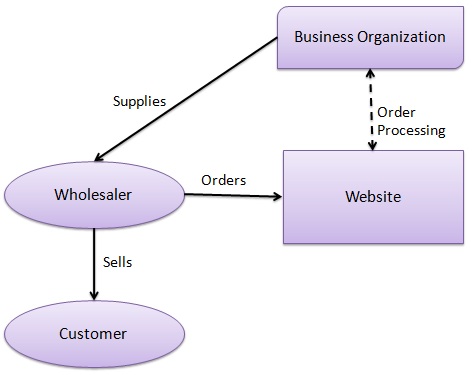 | Figure 2. B2B e-commerce business model (source:www.google.com) |
5.3. Business-to-Customer (B2C)
- B2C stands for “business-to-customer” and applies to any business or organization that sells its product or services to consumers over the internet for its own use. When most people think of B2C e-commerce, they think of Amazon, the online bookseller that launched its site in 1995 and quickly took on the nation’s major retailers.In addition to online retailers, B2C has grown to include services such as online banking, travel services, online auction, health information and real estate sites.
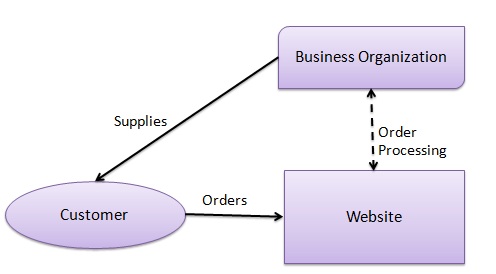 | Figure 3. B2C business model (source: www.tutorialspoint.com) |
5.4. Mobile Commerce (M-Commerce)
- The name “M-Commerce” arises from the mobile nature of the wireless environment that supports mobile electronic business transactions. Devices, including digital cellular phones, Personal Digital Assistants (PDAS), pagers, notebooks, and even automobiles can already access the Internet wirelessly and utilize its various capabilities, such as e-mail and webs browsing. [6] Once connected, mobile consumer’s can conduct transactions, including stock trades, in-store price comparison, banking, air ticket reservation and many more.Bank of America predicts $67 billion in purchase will be made from mobile devices by European and American shoppers in 2015. Forrester Research Inc. has also projected annual (2012–2016) growth in billion dollars for M-Commerce; the figure below throws more light on it.
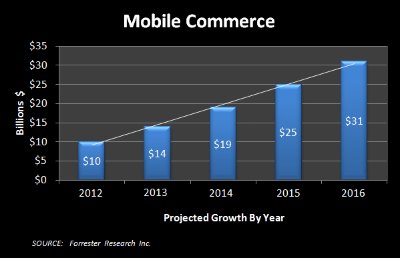 | Figure 4. Annual growth of M-commerce (source: Forrester Research Inc.) |
5.5. Peer-to-Peer (P2P)
- P2P is a type of transient internet that allows a group of computer users with same networking program to connect with each other and directly access files from one another’s hard drives. Napster and Gnutella are examples of P2P software. [12]The user downloads and execute peer-to-peer networking program. After launching the program, the user enters the IP address of another computer belonging to the network. Once the computer finds another network member on-line, it will connect to that user’s connection. Users can choose how many member connections to seek at one time and determine which files they wish to share.
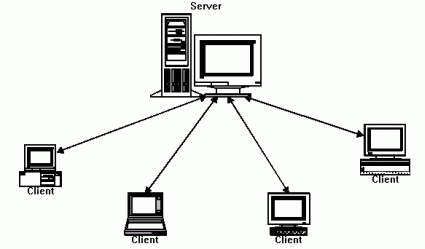 | Figure 5. P2P business model (source: www.google.com) |
6. Difference between E-commerce and E-business
- There is debate among consultants and academicians about the difference between e-commerce and e-business.The term e-commerce and e-business are now often seen and use interchangeably. However, though related they have different meanings.
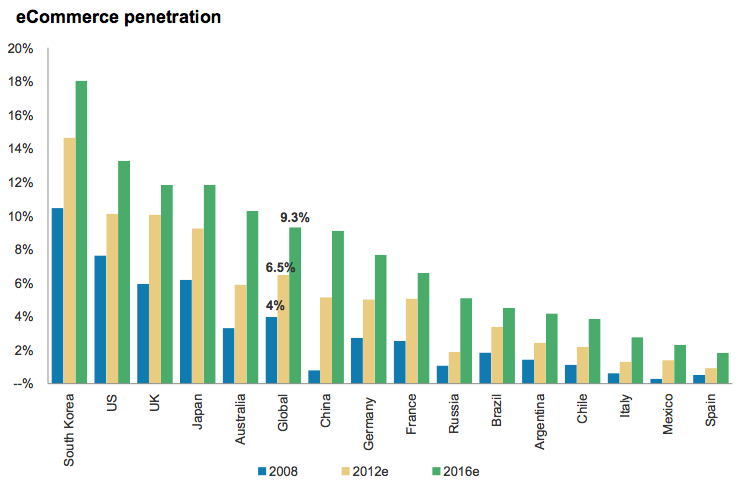 | Figure 6. E-commerce penetration (source: www.google.com) |
 | Figure 7. E-business model (source: www.ausweb.scu.edu.au) |
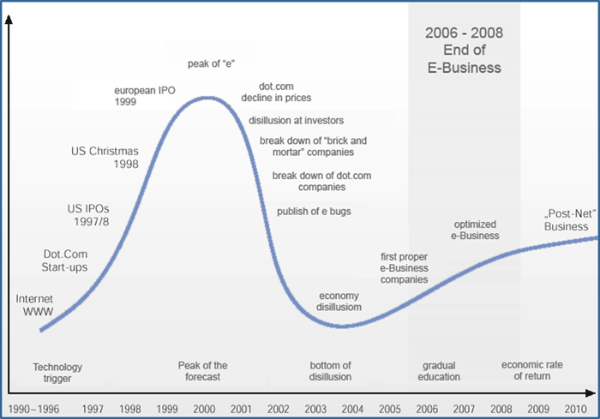 | Figure 8. Trends in e-business (source: www.softlution.com) |
7. Benefits of E-Commerce
- Electronic commerce enables reduced inventories and overheads by facilitating ‘pull’-type supply chain management- this is based on collecting the customer order and then delivering through JIT (just-in-time) manufacturing. This is particularly beneficial for companies in the high technology sector, where stocks of components held could quickly become obsolete within months. For instance, companies like Apple (mobile phones) and Dell (computers) gather customers’ orders for a product, transmits them electronically to the manufacturing plant where they are manufactured according to customer’s specifications and sent them to the customer within a few days. [13]Price comparison; customers can ‘shop’ around the world and conduct comparisons either directly by visiting different sites, or by visiting a single site where prices are aggregated from a number of providers and compared.In e-commerce there is the possibility of the small companies to compete with the large companies. Due to small expenses incurred by a virtual shop, small companies are confronting with one less barrier in penetrating the markets already dominated by the large companies. More than this due to her flexibility and perception towards new the small company has a major advantage in comparison with a large one dominated by bureaucracy and conservationism. [24]E-commerce makes it possible to conduct a round clock business which most people refer to as 24/7 business transactions. With the 24/7 buying and selling on internet, e-commerce has abolished the time restrictions on business transactions. This is very beneficial as it helps in sales increment as well as profit.
8. Some Barriers to the Growth of E-commerce
- Technical barrier; many technical problems still prevail and are clearly seen as major barrier to the growth of global e-commerce. On the whole, the most significant barriers to the use and proliferation of e-commerce are perceived to be of technical nature. Not only did technical issues come up throughout our open discussions with the interviewees; they were also cited frequently among the top three key issues; infrastructure issues, organizational-level problems related to the integration of new e-commerce solutions to existing legacy systems, standard issues, issues related to the capabilities of the internet, and security concerns. [10]Corruption renders e-commerce difficult; corruption is a huge problem for international trade in general, often in relation to customs procedures, and relates to anything from bribery to disappearance of items. Both small and large businesses highlight this problem. An increasing number of businesses deemed e-commerce to be particularly sensitive to corruption, as it is often many small consignment that are shipped, which are “easier to misplace” and e-traders often do not have a staff on site to be able to follow up any problems. One business explained that it had decided to leave the Chinese market and another that it had decided not to start selling to Russia, due to corruption. In addition, Turkey, Ukraine and other Eastern European countries were mentioned as problematic with regards to e-commerce corruption. [19]Cognitive barrier; cognitive factors are related to mental maps of individuals and organizational decision makers. Most analysts argue that cognitive barrier is more serious than other forms of barrier in developing countries. Effects such as inadequate awareness, knowledge skills, and confidence serve as cognitive feedbacks. In most developing countries, organizations, businesses, technological resources, a lack of awareness and understanding of potential opportunities, risk aversion and inertia often lead to a negative assessment of e-commerce. Another consideration with cognitive barrier is related to general and computer illiteracy and lack of English language skills. Note that most software, human-computer interfaces and contents on the web are in English. Estimates suggest that half of the population in developing countries cannot speak an official language (English) of their countries especially the old generations. [25]
9. Future Research
- Further research needs to be conducted on some of the major types of e-commerce (C2C, B2B, and B2C). It would be interesting to conduct research on the statistics of these types of e-commerce to know how they contribute to the growth of various firms around the globe presently.
10. Conclusions
- E-commerce technology has helped firms in many different ways. Not only has it helped businesses and firms to sell their products and services globally and easily but has also helped customers to shop at comfort anytime everywhere.Since it existence to date, there have been no limitation in finding advance technologies to suit the present situation of e-commerce by experts and businesses. This means that the e-commerce we see today would not be same in the next five years. E-commerce will see tremendous growth and advance in technology as it continues to gain root in businesses in both developed and developing countries.As the say goes “growth comes with many benefits as well as challenges” therefore, we must put ourselves in a better position to be able to handle the challenges that accompany the growth of e-commerce technology.
ACKNOWLEDGEMENTS
- I would like to acknowledge Prof. Jingwen Li, dean of School of Economics and Management at Beijing University of Technology for his supervision. My sincere appreciation goes to Prof. Feng, MIS lecturer at BJUT. Finally, I would like to thank all my friends and classmates at BJUT for their support.
 Abstract
Abstract Reference
Reference Full-Text PDF
Full-Text PDF Full-text HTML
Full-text HTML